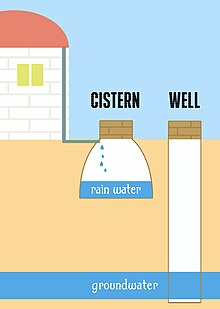
Back خزان أرضي Arabic Sistern Azerbaijani Цистерна Bulgarian Cisterna BS Cisterna Catalan Cisterne Danish Zisterne German Cisterno Esperanto Cisterna Spanish Tsistern Estonian
This article needs additional citations for verification. (April 2023) |


A cistern (from Middle English cisterne; from Latin cisterna, from cista 'box'; from Ancient Greek κίστη (kístē) 'basket'[1]) is a space excavated in bedrock or soil designed for catching and storing water.[2][3] To prevent leakage, the interior of the cistern was often lined with hydraulic plaster.[3]
Cisterns are distinguished from wells by their waterproof linings. Modern cisterns range in capacity from a few litres to thousands of cubic metres, effectively forming covered reservoirs.[citation needed][4]
- ^ "cistern". Webster's New Collegiate Dictionary (9th ed.). 1990.
- ^ "Cisterns". National Geographic Society.
- ^ a b Reich, Ronny; Katzenstein, Hannah (1992). "Glossary of Archaeological Terms". In Kempinski, Aharon; Reich, Ronny (eds.). The Architecture of Ancient Israel. Jerusalem: Israel Exploration Society. p. 312. ISBN 978-965-221-013-5.
- ^ "Cistern Design" (PDF). North Carolina Department of Agriculture and Consumer Services. Retrieved 2020-04-13.
© MMXXIII Rich X Search. We shall prevail. All rights reserved. Rich X Search